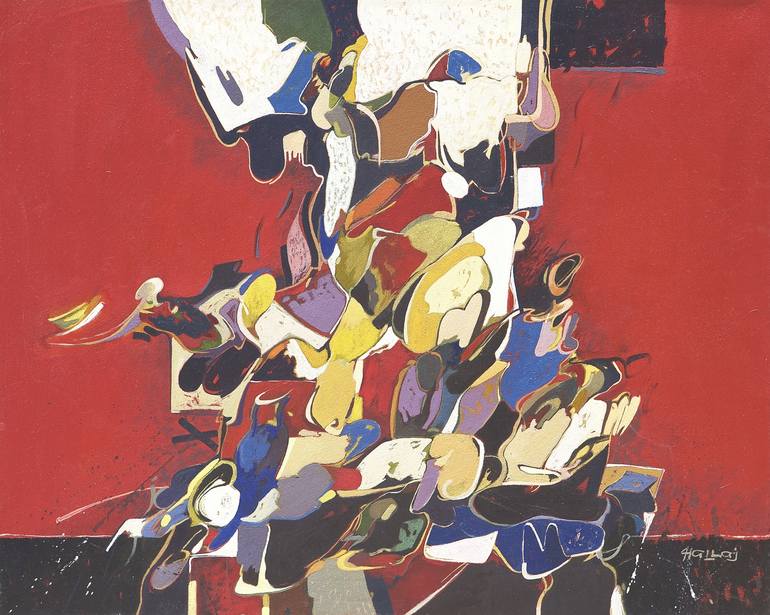Happy New You

Yesterday was Happy New Year,
From now on
It’s Happy New You,
Year no more the main attraction,
Not the issue or the question.
One wakes up to to see, to hear
That fireworks have injured nearly
Fifty; cars burnt out, abuse –
And that is just the local news.
Personally, I feel just fine
Despite the champagne, sweets and wine;
My husband too.
All I can say is Happy You,
My hope that you’re refreshed each day,
Fresh and alive
The next three hundred sixty five!

Abrasax #365 -- Samuel Hallaj
Basilides was a 1st-century Gnostic religious teacher in Alexandria, Egypt, who claimed to have inherited his teachings from St. Matthias (Mattityahu), who had been chosen by lot to replace Judas after he had betrayed Jesus; however, he may have been a pupil of Simon Magus’ successor Menander. His own followers persisted for another 2 centuries in Egypt and elsewhere. “Abrasax” (or Abraxas) was a word they applied to the megas archon (great archon); an archon was a servant of the Demiurge (the creator-god who that stood between humanity and a transcendent God that could only be reached through gnosis [“knowledge,” the insight into their real, divine, nature, which would deliver them from the constraints of earthly existence]). The argons were the princepes of the 365 ouranoi (spheres). [An archon was a Greek official, while a princeps was a Latin term adopted by the 1st emperor to indicate he was the “first among equals”to allay senatorial opposition to his rule.] According to the 2nd-century bishop Irenaeus of Lugdunum (Lyon), an opponent of the Basilides, Nous (intellect) was a product of "the Unbegotten Father" and was the progenitor of Logos (logic), from which came Phronesis (practical knowledge), leading to Sophia (wisdom) and Dynamis (possibility), leading to principalities, powers, and the angels who created "the 1st heaven." They in turn originate a 2nd series, who create a 2nd heaven, and so forth, until 365 heavens are in existence. The 365th heaven is visible to us, and its angels are the authors of our world. Abrasax was the princeps the 365th heaven. According to the rules of isopsephy (“equal” + “pebble,” used by the Greeks as a teaching tool for arithmetic and geometry), the 7 Greek letters (corresponding with the 7 planets) in ABRASAX adds up to 365, the number of days in a year; the Basilidians also identified 365 parts in a human body. In the 4th century bishop Epiphanius of Salamis reported that they regarded Abrasax as "the power above all, and First Principle … the cause and first archetype" of all things; in other accounts it was Abrasax who had given birth to Nous, that all 365 heavens were created in his honor, and that he had sent Christ into the world as “a benevolent ghost.” A number of Hellenistic papyri contain magical spells, formulae, hymns, and rituals invoke Abrasax. In one he was identified as part of the "true name which has been transmitted to the prophets of Israel" of the "Headless One, who created heaven and earth, who created night and day... Osoronnophris [Osiris the Perfect Being] whom none has ever seen... awesome and invisible god with an empty spirit." In the “Eighth Book of Moses” Abrasax was identified as the name of the creator-god in the language of the baboons: His 1st laughter created light; his 2nd divided the primordial waters; his 3rd created the mind; his 4th created fertility and procreation; his 5th created fate; his 6th created time (the sun and moon), and his 7th created the soul; through various sounds he created the serpent Python who "foreknew all things," the 1st man (Fear), and the god Iaō, who derived his power from the other two and was given precedence by Abrasax over all other gods.
ReplyDeleteBetween 1913 and 1917 Carl Jung began an intense "confrontation with the unconscious" via a series of imaginative or "visionary" states of consciousness, and then less vigorously until 1923. He carefully recorded his experiences in 6 notebooks (the "Black Books," referring to their covers rather than their contents), which, in late 1914, he began transcribing into a draft manuscript of his “Red Book,” a folio-sized leather-bound illuminated volume he intended as the formal record of his experiments; though he kept the journal private, he repeatedly said that the accounts in the “Red Book” contained the nucleus of all his later works. In 1916 he privately published the final section as “Seven Sermons to the Dead, written by Basilides of Alexandria, the city where East and West meet;” this was later (1962) included as an appendix to his biographical memoir, “Memories, Dreams, Reflections,” but the “Red Book” as a whole was not published until 2009, nearly 50 years after his death. In it “Abraxas” was a representation of the driving force of individuation (synthesis, maturity, oneness): “He is less definite than God or Devil.... Abraxas is activity: nothing can resist him but the unreal ... If the Pleroma [the totality of divine powers; according to Jung, it is both "nothing and everything. It is quite fruitless to think about pleroma. Therein both thinking and being cease, since the eternal and infinite possess no qualities"] were capable of having a being, Abraxas would be its manifestation…. That which is spoken by God-the-Sun is life; that which is spoken by the Devil is death; Abraxas speaketh that hallowed and accursed word, which is life and death at the same time. Abraxas begetteth truth and lying, good and evil, light and darkness in the same word and in the same act.”
ReplyDelete